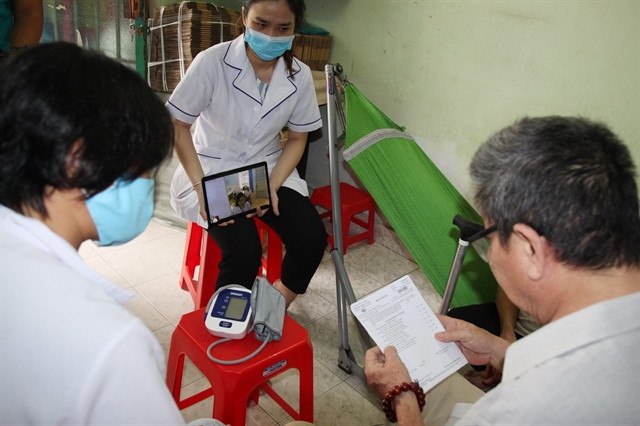 Society
Society

Health centres and stations in HCM City’s districts, wards and communes have failed to attract patients because of a shortage of facilities, medicines and doctors.

|
| A nurse at a health station in Gò Vấp District’s Ward 16 helps a patient connect with the station’s telemedicine health examination system. VNA/VNS Photo Đinh Hằng |
HCM CITY— Health centres and stations in HCM City’s districts, wards and communes have failed to attract patients because of a shortage of facilities, medicines and doctors.
A 70-year-old man from District 12, for example, told Sài Gòn Giải Phóng (Liberated Sài Gòn) newspaper that he often visits District 12 Hospital instead of his ward’s health station, and only brings his grandchild to the health station for vaccinations.
The health station in the ward where the man lives once had spacious and sufficient facilities, but in 2017 the station was forced to move to Tân Thới Hiệp Cultural House in the ward to build a supermarket.
The ward People’s Committee planned to build a new facility for the station, but it has not been built because of investment and site clearance problems.
In District 10, the health station in the Lý Thường Kiệt apartment building in Ward 7 is narrow, about 20 metres long and 3 metres wide. It is not in good condition, and has no doctor. Only around 10 people visit for health examination and treatment each month.
In District 1, 10 health stations need to be upgraded, and seven of the health stations need to be equipped with more medical devices.
Three health centres and stations in District 2 need to be rebuilt, while District 4 needs nearly VNĐ400 billion (US$17.2 million) to build new facilities for health stations in its wards 1, 15, and 18, and for health centres.
At a conference with the city Department of Health and representatives of health stations and centres held on November 19, the department’s deputy head Tăng Chí Thượng said the number of patients at health centres and stations in the city’s districts, wards and communes accounted for a low percentage of the total number.
Only 1.2 million to 2.7 million patients visited these centres and stations each year, accounting for 4 per cent to 7.5 per cent of the city’s total patients.
People in the city still preferred going to hospitals, Thượng said.
The department would try to resolve this problem, he said, adding that the city wanted to develop primary healthcare services at grassroots-level health facilities. Higher-level hospitals should focus on treating patients who are seriously ill.
The city has 24 health centres in districts and 319 health stations in wards and communes.
Of the 319 health stations in wards and communes, 27 operate based on the principles of family medicine. These stations have attracted many patients.
Thượng instructed the rest of the health stations to speed up the transformation process to operate based on the principles of family medicine.
The department would also open more training courses for managers of health centres and stations to improve management skills, he said.
It would check and provide vital medical devices to primary healthcare services, and use IT to manage them.
The health insurance fund does not cover health examination and treatment for patients at many health stations and centres, which is one of the reasons patients do not go to them. VNS




